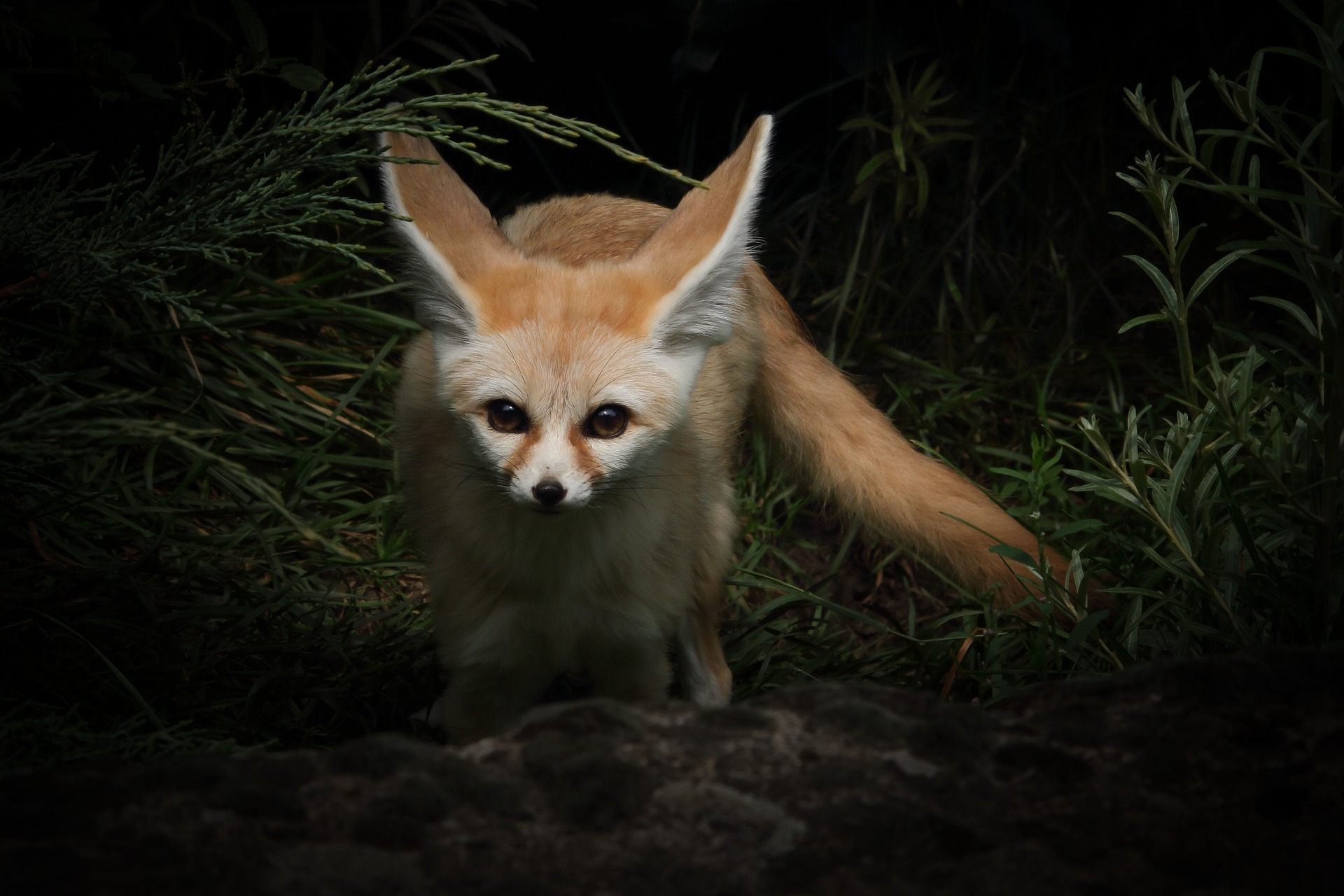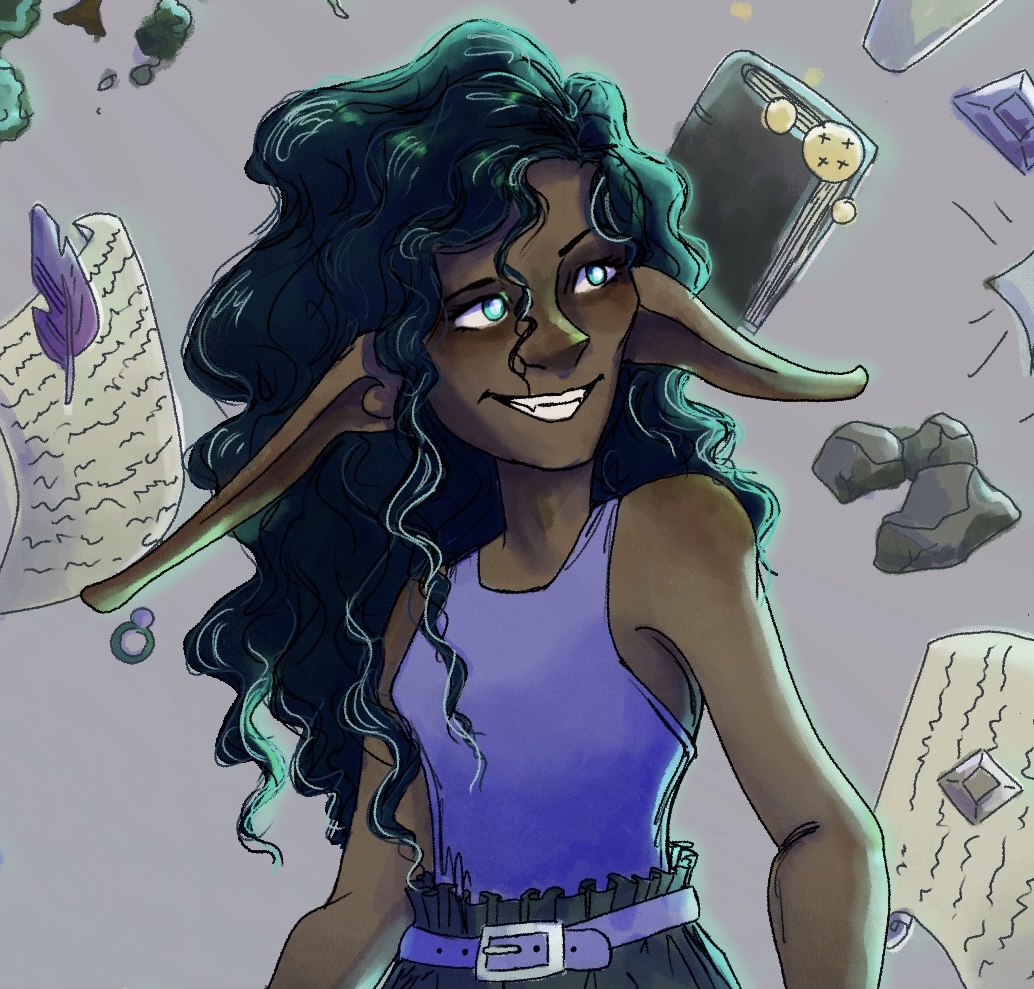Flamarj
Reknown also as Firefox of the desert, while inactive during the day due to the scorching sun of Arquir desert, this little mammal is mostly active during the night when they come out of their dens to hunt smaller preys such as Jerboas, Notomys or Kangaroo rats.
Basic Information
Anatomy
A small canid with short soft fur straw coloured, that improves the camouflage, with reddish reflexes. The most appearent feature of this animal are the large ears that allows effective dissipation of the temperature, is one of the canids with the largest ratio between body volume and ears surface. Female individual are around 36cm between head and body, with a tail around 22cm, while males are slightly larger. The tail is another important feature of this species because when threatened they can ignite their tail concentrate their body temperature, this mechanism last only for a short time but if usually sufficient to scare away predators, unless they are caught unaware. Their eyes are large and dark, provided with a large portion of tapetum lucidum making them effective hunters in the darkness. The pad of the feet are covered in soft dense fur increasing their ability to walk in sandy hot terrains.
Genetics and Reproduction
The reproductive season occurs once a year during the spring months, when preys availability is highest. The pregnancy lasts around 50-52 days, during which the male protects the den aggressively and hunts to also feed the pregnant female. In normal circumstances both parents look after the puppies and those remain in the den, if enough space is available, even once they reach the adult age. A male and a female bond for life and, only if one of the two dies, look for a new partner.

Growth Rate & Stages
Puppies born with closed eyes and open them after about two weeks, in the first weeks of their lives they are entirely dependant from their mother. They start to feed on adult food around 30-35 days and reach sexual maturity around 9 months. Around one year of age they are expected to be fully grown to adult size.
Ecology and Habitats
They are nocturnal animals specialized to live in dry and sandy environment. The color of their fur makes them very hard to spot against the sand and the conformation of their paws allows them to move very quietly. Kidneys are adapted to grant a very effective recovery of water, therefore they need to drink very little to survive and often water is obtained from the food. Their predators are other mammals of bigger size such as jackal, coyotes, caracals and, prevalently, wargs. Puppies that venture from the burrows can be captured as well from nocturnal birds of prey.
Dietary Needs and Habits
Compulsory carnivore, Flamarj hunts prevalently small prays ideally birds and rodents, but can complement its diet with reptiles such as geckos and lizards, or insect such as desertic dragonfly and locusts. They hunt at night and, if possible, they bring back the preys to the burrow to be shared with the other members of community. They hunt in a wide range most of the year, although during the reproductive period and until the puppies are able to hunt for themselves, the protection of the burrow becomes a priority, reducing the range significantly.
Biological Cycle
The life of Flamarj is affected by the seasonal alternation, the rain season affects the safety of dens and makes hunting more difficult therefore it is a dangerous time of the year. For a bizzare case of life, the only time of the year in which water is plentiful poses different threats to a species so specialized to live in a dry environment, fortunately the duration is limited to roughly six weeks, contributing in balancing the numbers of this predator in their habitat.
Additional Information
Social Structure
Flamarj live in large communities originated from the confluence between familiar units, often the puppies once reached the adulthood and bonded to a partner will join in the familiar burrow, at least until there is space available. They dig large burrows that often extend up to 120m2, with large chambers connected by smaller tunnels occasionally with more than one exit to the surface.
Domestication
It is said that Flamarj can be domesticated but the task is hard and it can take several months, assuming that the captive Flamarj doesn't manage to escape before getting domesticated. There are better chances to domesticate a puppy, but getting it from the control of the parents its very complex.
Uses, Products & Exploitation
Flamarj individuals get hunted by humans, especially of Hintadu people who consider the pelts of this animal a sign of prowess and skills. Western people have recently grown more interested in importing the Flamarj furs too.
Geographic Origin and Distribution
Flamarj are present in most of the Arquir desert, although they prefer to create their burrows in areas where the terrain is relatively firm. They can adapt to live in the tundra and savannah areas surrounding the desert, but they tend to struggle in these types of environment.
Average Intelligence
Flamarj are of average intelligence, but in their hunting habits can be pretty smart alternating solo techniques to group hunting. Using their sneaking skills at their advantage to attack unaware preys. If attacked and unable to escape they ignite their tails concentrating the heat from the air and using it to scare away predators. It is reported of Flamarj that have been captured by Hintadu and Otadan hunters and have ignited their tail to escape from the wooden enclosures where they where confined.
Perception and Sensory Capabilities
The two senses that are more effective in Flamarj are hearing and sight, although while the eyes are mostly effective in darkness, the hearing is efficient both in open spaces and underground where these animals spend their days. Therefore if forced to venture outside during the daytime their vision is dimmed and they have to rely mostly on hearing.
Civilization and Culture
Courtship Ideals
During the mating season, males that aren't bonded to a partner take part to the ritual of selection facing each other hissing, barking, yapping and fighting until a female individual shows her interest.
Relationship Ideals
After the ritual of selection, a selected male and his female partner distance themselves from the community is a ritual of bonding that culminates in their first coupling, from that moment on the couple will be bonded until one of the two dies or is otherwise impeeded to return to the burrow. In this case, after a short time the surviving Flamarj will go back in the ritual of mating to select, or be selected by, a new partner.

Vulpes flamma
Arquir Desert
10 years
Although survival in the harsh desertic environment is complicated, this species is fully adapted to its habitat and at the moment is not in danger of extinction.






Aw they're adorable! And it's really sweet that they mate for life. Or at least, until one of them dies! I also really like that the females pick their mate.
I love Fennec foxes so it was funny to tweak it a bit to make my own species. <3
Fennec foxes are adorable, no doubt! They're so energetic, and fun. :D